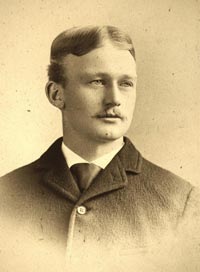Ernest Amory Codman
Ernest Amory Codman (born December 30, 1869 in Boston , Massachusetts , † November 23, 1940 in Ponkapog , Massachusetts) was an American surgeon and pioneer in the field of public health . He was the first American doctor to systematically monitor his patients' recovery after discharge. He is considered the founder of so-called outcome management , which measures the quality of medical care based on the long-term treatment outcome for the patient. His interest in improving the quality of medical care also led him to serve as a founding member of the American College of Surgeons . Codman also founded the first database for recording bone tumors in the USA.
Codman was a vocal advocate of health system reform. He followed the recovery process of his patients using "End Result Cards". These contained the respective diagnosis, the treatment carried out and the treatment result for each individual patient. To determine the end result of his treatments, patients were followed up for at least one year after their discharge. Codman was of the opinion that the long-term prognosis of patients suffered, especially due to incorrect medical treatment. Throughout his life, he strived to achieve a universal, systematic recording of the end-of-treatment results for all patients. He saw this as an opportunity to gain the necessary experience from failure of patient treatment in order to treat patients better in the future. He continued to intend to make this information publicly available to help patients make choices about doctors and hospitals.
Codman graduated from Harvard Medical School in 1895 and began residency training at Massachusetts General Hospital . He later founded the first morbidity and mortality conferences. The purpose of these conferences is to allow doctors to exchange information about treatment errors that have occurred and to warn colleagues about these or similar errors. In 1914 he developed a more advanced plan for assessing the professional competence of surgeons. However, the MGH, as its employer, refused to implement its plan and responded by withdrawing employee privileges. Up to this point Codman had been a respected surgeon and had a very successful academic career; Among other things, he wrote the first description of the chondroblastoma and developed new anesthetic methods together with Harvey Cushing .
Dr. Codman later founded his own clinic in Boston to implement his reform ideas to measure - and then improve - the quality of medical care. In the treatment of 337 patients between 1911 and 1916, he registered 123 treatment errors. He eventually published his experiences from this period in a privately published book, A Study in Hospital Efficiency .
Codmann also first described a fracture classification in 1934. This segments the humeral head fracture into four fragments and was later called the Codman classification.
Codman sacrificed his academic career to struggle to implement his reform ideas. He continued to operate in his own clinic, but lost his prestigious relationships with Harvard and its Massachusetts General Hospital.
Web links
- Ernest Amory Codman: A study in hospital efficiency: as demonstrated by the case report of the first five years of a private hospital (1918) . The Medical Heritage Library: http://archive.org/details/studyinhospitale00codm
- Bill Mallon: E. Amory Codman Pioneer New England Shoulder Surgeon , New England Shoulder and Elbow Society: http://www.neses.com/news.php
- Francis A. Countway Library of Medicine. Center for the History of Medicine. Harvard Medical Library and Boston Medical Library: Codman, EA (Ernest Amory), 1869-1940. Papers, 1849-1981: Finding Aid.
Individual evidence
- ^ Berwick DM "EA Codman and the rhetoric of battle: a commentary." Milbank Quarterly, 67 (2): 262−267, 1989.1 5.
- ^ Donabedian A. "The end results of health care: Ernest Codman's contribution to quality assessment and beyond." Milbank Quarterly, 67 (2): 233−256, 1989.
- ↑ Traditional classification models p. 10
| personal data | |
|---|---|
| SURNAME | Codman, Ernest Amory |
| ALTERNATIVE NAMES | Codman, Ernest A. |
| BRIEF DESCRIPTION | American medic |
| DATE OF BIRTH | December 30, 1869 |
| PLACE OF BIRTH | Boston , Massachusetts |
| DATE OF DEATH | November 23, 1940 |
| Place of death | Ponkapog , Massachusetts |
